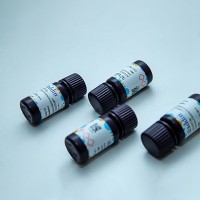Characterization of CGRP Receptor Binding
互联网
- Abstract
- Table of Contents
- Materials
- Figures
- Literature Cited
Abstract
CGRP receptor binding may be measured using homogenates of cell membranes or intact cells. Here a microcentrifugation?based assay is described that utilizes radioiodinated CGRP in displacement studies to determine the binding parameters for any ligand that interacts with CGRP receptors. A similar assay is described for binding to cultured cells. The protocols may be adapted for other radioligands or for filtration?based assays. The main problems with CGRP binding assays can usually be traced to degradation of the radioligand or displacing ligands. Also, some cell lines fail to express CGRP receptors after extensive passage. CGRP binding assays provide a rapid and easy approach for distinguishing between receptors for CGRP and related peptides such as adrenomedullin and amylin.
Keywords: CGRP; RAMP1; microcentrifugation; filtration; intact cell binding; membrane binding
Table of Contents
- Basic Protocol 1: Binding of CGRP to Membranes from Homogenized Tissues or Cells
- Basic Protocol 2: Binding of CGRP to Intact Cells
- Alternate Protocol 1: Saturation Binding to obtain Kd and Bmax Directly
- Alternate Protocol 2: Rapid Filtration Assay
- Alternate Protocol 3: CGRP8‐37 Binding
- Support Protocol 1: Preparation of Membranes
- Reagents and Solutions
- Commentary
- Literature Cited
- Figures
- Tables
Materials
Basic Protocol 1: Binding of CGRP to Membranes from Homogenized Tissues or Cells
Materials
Basic Protocol 2: Binding of CGRP to Intact Cells
Materials
Alternate Protocol 1: Saturation Binding to obtain Kd and Bmax Directly
Materials
|
Figures
-

Figure 1.30.1 Displacement of [125 I]CGRP by unlabeled CGRP in membranes prepared from Cos 7 cells transfected with CL and RAMP1. Total cpm are shown on the y axis. Nonspecific binding in this example was 440 cpm, with a resulting K i of 0.6 nM and a Hill coefficient of 0.65. [125 I]CGRP was present at 40 pM. View Image
Videos
Literature Cited
| Literature Cited | |
| Aiyar, N., Disa, J., Siemens, I.R., and Nambi, P. 1997. Differential effects of guanine nucleotides on [125I]‐hCGRP(8‐37) binding to porcine lung and human neuroblastoma cell membranes. Neuropeptides. 31:99‐103. | |
| Bhogal, R., Smith, D.M., Purkiss, P., and Bloom, S.R. 1993. Molecular identification of binding sites for calcitonin gene‐related peptide (CGRP) and islet amyloid polypeptide (IAPP) in mammalian lung: Species variation and binding of truncated CGRP and IAPP. Endocrinology. 133:2351‐2361. | |
| Chatterjee, T.K. and Fisher, R.A. 1991. Multiple affinity forms of the calcitonin gene‐related peptide receptor in rat cerebellum. Mol. Pharmacol. 39:798‐804. | |
| Choksi, T., Hay, D.L., Legon, S., Poyner, D.R., Hagner, S., Bloom, S.R., and Smith D.M. 2002. Comparison of the expression of calcitonin receptor‐like receptor (CL) and receptor activity modifying proteins (RAMPs) with CGRP and adrenomedullin binding in cell lines. Br. J. Pharmacol. 136:784‐792. | |
| Dennis, T., Fournier, A., St. Pierre, S., and Quirion, R. 1989. Structure‐activity profile of calcitonin gene‐related peptide in peripheral and brain tissues. Evidence for receptor multiplicity. J. Pharmacol. Exp. Ther. 251:718‐725. | |
| Doods, H., Hallermayer, G., Wu, D., Entzeroth, M., Rudolf, K., Engel, W., and Eberlein, W. 2000. Pharmacological profile of BIBN4096BS, the first selective small molecule CGRP antagonist. Br. J. Pharmacol. 129:420‐423. | |
| Juaneda, C., Dumont, Y., and Quirion, R. 2000. The molecular pharmacology of CGRP and related peptide receptor subtypes. Trends Pharmacol. Sci. 21:432‐438. | |
| McLatchie, L.M., Fraser, N.J., Main, M.J., Wise, A., Brown, J., Thompson, N., Solari, R., Lee, M.G., and Foord, S.M. 1998. RAMPs regulate the transport and ligand specificity of the calcitonin‐receptor‐like receptor. Nature. 393:333‐339. | |
| Muff, R., Buhlmann, N., Fischer, J.A., and Born, W. 1999. An amylin receptor is revealed following co‐transfection of a calcitonin receptor with receptor activity modifying proteins‐1 or ‐3. Endocrinology. 40:2924‐2927. | |
| Poyner, D.R., Andrew, D.P., Brown, D., Bose, C., and Hanley, M.R. 1992. Pharmacological characterization of a receptor for calcitonin gene‐related peptide on rat, L6 myocytes. Br. J. Pharmacol. 105:441‐447. | |
| Poyner, D.R., Taylor, G.M., Tomlinson, A.E., Richardson, A.G., and Smith, D.M. 1999 Characterization of receptors for calcitonin gene‐related peptide and adrenomedullin on the guinea‐pig vas deferens. Br. J. Pharmacol. 126:1276‐1282. | |
| Poyner, D.R., Sexton, P.M., Marshall, I., Smith, D.M., Quirion, R., Born, W., Muff, R., Fischer, J.A., and Foord, S.M. 2002. International Union of Pharmacology XXXII. The mammalian CGRP, adrenomedullin, amylin and calcitonin receptors. Pharmacol. Rev. 54:233‐246. | |
| Quirion, R., Van Rossum, D., Dumont, Y., St‐Pierre, S., and Fournier, A. 1992. Characterization of CGRP1 and CGRP2 receptor subtypes. Ann. N. Y. Acad. Sci. 657:88‐105. | |
| Schindler, M. and Doods, H.N. 2002. Binding properties of the novel, non‐peptide CGRP receptor antagonist radioligand, [(3)H]BIBN4096BS. Eur. J. Pharmacol. 442:187‐193. | |
| Tilakaratne, N., Christopoulos, G., Zumpe, E.T., Foord, S.M., and Sexton, P.M. 2000. Amylin receptor phenotypes derived from human calcitonin receptor/RAMP coexpression exhibit pharmacological differences dependent on receptor isoform and host cell environment. J. Pharmacol. Exp. Ther. 294:61‐72. | |
| Van Rossum, D., Dumont, Y., Fournier, A., St‐Pierre, S., and Quirion, R. 1992. Effect of dithiothreitol and Gpp(NH)p on [125I] alpha‐hCGRP binding sites in brain and peripheral tissues. Ann. N.Y. Acad. Sci. 657:429‐431. | |
| Van Rossum, D., Hanisch, U.K., and Quirion, R. 1997. Neuroanatomical localization, pharmacological characterization and functions of CGRP, related peptides and their receptors. Neurosci. Biobehav. Rev. 21:649‐78. | |
| Yoshizaki, H., Takamiya, M., and Okada, T. 1987. Characterization of picomolar affinity binding sites for [125I] calcitonin gene‐related peptide in rat brain and heart. Biochem. Biophys. Res. Comm. 146:443‐451. |




![[Cys(ACM)²'⁷]CGRP,Moligand™,阿拉丁](https://img1.dxycdn.com/p/s14/2024/0619/239/2939736506151833081.jpg!wh200)


